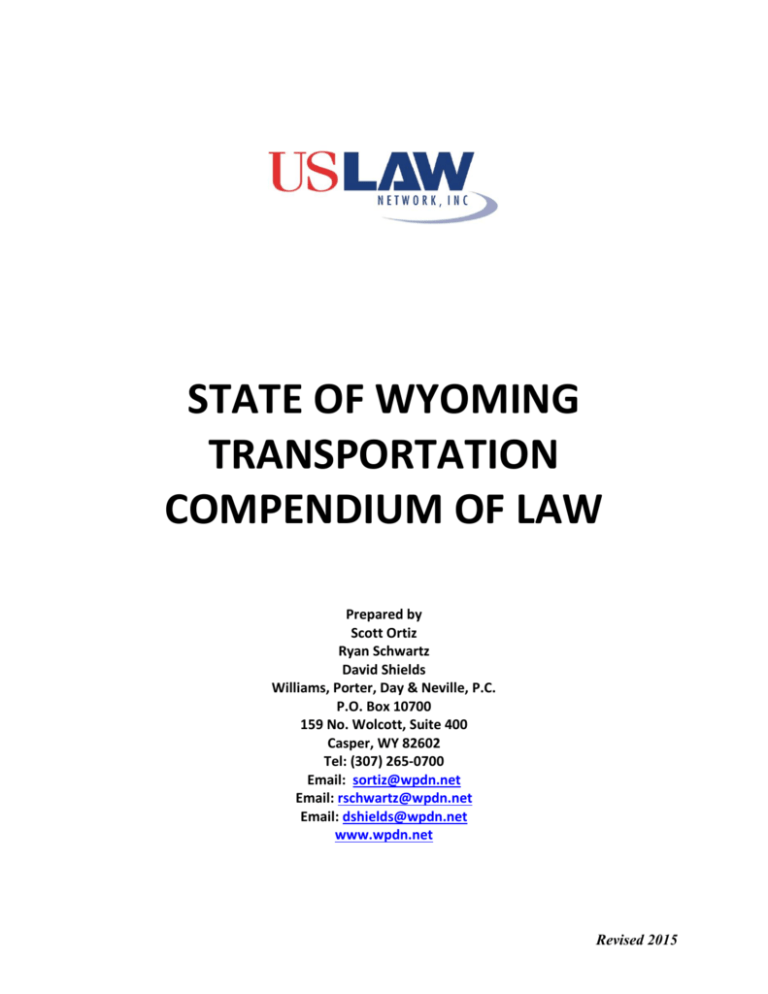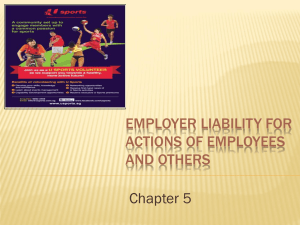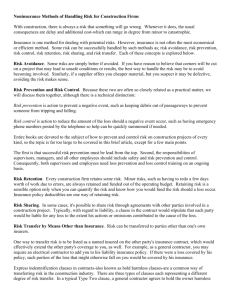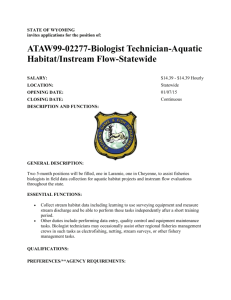Wyoming
advertisement

STATE OF WYOMING TRANSPORTATION COMPENDIUM OF LAW Prepared by Scott Ortiz Ryan Schwartz David Shields Williams, Porter, Day & Neville, P.C. P.O. Box 10700 159 No. Wolcott, Suite 400 Casper, WY 82602 Tel: (307) 265-0700 Email: sortiz@wpdn.net Email: rschwartz@wpdn.net Email: dshields@wpdn.net www.wpdn.net Revised 2015 Elements of Proof for the Derivative Negligence Claims of Negligent Entrustment, Hiring/Retention and Supervision In Wyoming, there exist four often commingled theories by which an employer might be held to have derivative or dependent liability for the conduct of an employee. Derivative or dependent liability simply means that one element of imposing liability on the employer is a finding of culpability by the employee in causing an injury to a third party. In other words, if the driver is exonerated, the carrier cannot be liable. 1. Respondeat Superior (Let the master answer) a. What are the elements necessary to establish liability under a theory of Respondeat Superior? In Wyoming, as a matter of public policy and economic requirement, a master is liable for damages caused by the negligence of his servant while acting within the scope of the servant's employment. Combined Ins. Co. v. Sinclair, 584 P.2d 1034, 1042 (Wyo. 1978). A finding of liability under a respondeat superior liability therefore requires proof of 1) an employment relationship; 2) negligence on the part of the employee that causes harm; and 3) the negligent act occurred within the scope of the employment relationship. 1). The Employment Relationship – Employee vs. Independent Contractor. A. EMPLOYEE: An employee is a person who, by agreement with another called the employer, performs or is to perform services for the employer, with or without compensation. The agreement may be written, oral, or implied by the behavior of the parties. In order for an employer and employee relationship to exist, the employer must have the right of control over the details of the work of the employee even though the right of control may not have been exercised. Wyoming Civil Pattern Jury Instruction 8.01, Austin v. Kaness, 950 P.2d 561 (Wyo. 1997). B. INDEPENDENT CONTRACTOR: An “independent contractor” is one who contracts to do work according to his own methods, means, and manner of doing the work and without being subject to the control, direction, or supervision of his employer, except as to the result of the work. 2 Revised 2015 a. The employer of an independent contractor is not liable for harm caused by an act of an independent contractor or employees of the independent contractor. b. However, If the employer of an independent contractor retains the right to direct the manner of an independent contractor’s performance or assumes an affirmative duty with respect to safety, then the employer may be liable for a breach of duty of reasonable care to the employee of an independent contractor even if the employee was injured during the very work the contractor was hired to perform. Jones v. Chevron U.S.A., Inc., 718 P.2d 890 (Wyo. 1986). c. The employer of an independent contractor may also be held liable when the workplace owner/employer exercises a controlling and pervasive role over the independent contractor's work. Franks v. Indep. Prod. Co., 96 P.3d 484, 489 (Wyo. 2004). C. JOINT ENTERPRISE: A joint enterprise exists if these four elements are present: (1) An agreement, express or implied; (2) A common purpose; (3) A common commercial or financial interest or profit motive; and (4) An equal right to exercise control of the joint enterprise. If a joint enterprise exists, all persons who are part of the joint enterprise are legally responsible for the negligence or fault of other persons acting within the course and scope of the joint enterprise. Holliday v. Bannister, 741 P.2d 89 (Wyo. 1987). 2). Course and Scope of Employment A. Wyoming has adopted The Restatement (Second) of Agency, § 228 (1958). The conduct of an employee is within the scope of his employment “only if it is of the kind he is employed to perform; it occurs substantially within the authorized time and space limits; and it is actuated, at least in part, by a purpose to serve the master.” Austin v. Kaness, 950 P.2d 561, 563 (Wyo. 1997), (citing Hamilton v. Natrona County Educ. Ass’n, 901 P.2d 381, 385 (Wyo. 1995). a. In a decision potentially important to the commercial transportation industry, the Wyoming Supreme Court 3 Revised 2015 found an employer not liable when one of its employees fell asleep while driving to the workplace even though the employee was given a per diem reimbursement for the travel to the worksite. The Court found that the employee’s decision to work a second night job and to live in a neighboring city requiring a lengthy commute was the proximate cause of the accident. This means that for an “employer to be liable for the actions of a fatigued employee on a theory of negligence, the fatigue must arise out of and in the course of employment . . . [because] . . . [t]o hold otherwise would charge an employer with knowledge of circumstances beyond his control. Naturally then, the scope of an employer's duty is bound by activity that the employer can actually control within the employment relationship.” Black v. William Insulation Co., 141 P.3d 123, 129 (Wyo. 2006). 2. Negligent Entrustment a. What are the elements necessary to establish liability under a theory of negligent entrustment? Wyoming has adopted the Restatement of Torts § 390 which provides “One who supplies directly or through a third person a chattel for the use of another whom the supplier knows or has reason to know to be likely because of his youth, inexperience, or otherwise, to use it in a manner involving unreasonable risk of physical harm to himself and others whom the supplier should expect to share in or be endangered by its use, is subject to liability for physical harm resulting to them. Jack v. Enterprise Rent-A-Car Co., 899 P.2d 891, 894 (Wyo. 1995) (citing Moore v. Kiljander, 604 P.2d 204, 206 (Wyo. 1979). Stated another way, a carrier can be liable if it entrusts a vehicle to an incompetent or reckless driver. In Wyoming, to maintain a claim for negligent entrustment, factual evidence must exist which proves that the entruster knew, or should have known, of the user's incompetence to operate a vehicle. Finch v. Canaday, 75 Wyo. 472, 483 (Wyo. 1956). 3. Negligent Retention/Hiring a. What are the elements necessary to establish liability under a theory of negligent retention/hiring? Wyoming has adopted the Restatement Second of Agency § 213 which provides “A person conducting an activity through servants or other agents is subject to 4 Revised 2015 liability for harm resulting from his conduct if he is negligent or reckless in the employment of improper persons or instrumentalities in work involving the risk of harm to others.” Cranston v. Weston County Weed & Pest Bd., 826 P.2d 251 (Wyo. 1992). 4. Negligent Supervision a. What are the elements necessary to establish liability under a theory of negligent supervision? This theory requires proof that (1) the employer knew or should have known of the employee’s dangerous proclivities after the employee’s hiring, and (2) the employer’s negligence was the proximate cause of the plaintiff’s injuries. The key difference between negligent hiring and supervision is the time in which the carrier has reason to know of the employee’s alleged dangerous proclivities. 5. Negligent hiring of independent contractors The Wyoming Supreme court in BASIC ENERGY SERVICES, L.P., v. PETROLEUM RESOURCE MANAGEMENT, CORP., and PRM PARTNERS I, LLC, ( February 2015) recently adopted § 411 restsatement( second) of torts. Negligence in Selection of Contractor. An employer is subject to liability for physical harm to third persons caused by his failure to exercise reasonable care to employ a competent and careful contractor (a) to do work which will involve a risk of physical harm unless it is skillfully and carefully done, or (b) to perform any duty which the employer owes to third persons. While § 411 describes the negligent conduct of the owner/operator which must be proven to succeed on a negligent hiring claim, a plaintiff must also prove the underlying tortious conduct of the independent contractor. In Cranston, we set forth the elements of a claim of negligent hiring. 826 P.2d at 258-59. Basic Energy must establish that: (1) PRM was negligent in hiring Hot Oil, pursuant to the Restatement (Second) of Torts § 411; (2) Hot Oil or its servants negligently caused Basic Energy’s injury; and (3) PRM’s negligence in hiring Hot Oil was the proximate cause of Basic Energy’s injury. Id. at 258-59. 6. Co-employee liability claims 5 Revised 2015 Under the Wyoming Workers’ Compensation Act, co-employees are immune if he/she was acting within the scope of their duties. WYO. STAT. ANN. § 27-14-104(a) (LexisNexis 2013). Thus, the Act provides an injured worker’s co-employee immunity for their ordinary negligence. As such, if an employee is injured at work by another employee, the injured employee may only receive benefits through the Act. The employee’s right to benefits is in lieu of all other claims or remedies, including remedies for ordinary negligence, he or she would have available to him or her if the injury occurred outside of work. The Wyoming Legislature, however, provided an exception to this general rule. According to the Act: The rights and remedies provided in this act for an employee including any joint employee, and his dependents for injuries incurred in extrahazardous employments are in lieu of all other rights and remedies against any employer and any joint employer making contributions required by this act, or their employees acting within the scope of their employment unless the employees intentionally act to cause physical harm or injury to the injured employee, but do not supersede any rights and remedies available to an employee and his dependents against any other person. WYO. STAT. ANN. § 27-14-104(a) (LexisNexis 2013) (emphasis supplied). As such, a co-employee is liable for the injured worker’s damages if and only if he or she “intentionally” acted to cause the harm. After extensive debate, the Wyoming Supreme Court articulated the co-employee liability standard as follows: A co-employee is liable to another co-employee if the employee acts intentionally to cause physical harm or injury. To act intentionally to cause physical injury is to act with willful and wanton misconduct. . . . In the context of co-employee liability, willful and wanton conduct requires the co-employee to have 1) actual knowledge of the hazard or serious nature of the risk involved; 2) direct responsibility for the injured employee’s safety and work conditions; and 3) willful disregard of the need to act despite the awareness of the high probability that serious injury or death may result. 6 Revised 2015 Hannifan v. Am. Nat’l Bank of Cheyenne, 2008 WY 65, ¶ 34 (fn. 2), 185 P.3d 679, 693 (fn. 2) (Wyo. 2008). The Court recently affirmed this standard in Herrera v. Phillips, et al., 2014 WY 118, ¶ 21, 334 P.3d 1225 (Wyo. 2014). As such, a supervisory co-employee’s mere knowledge of, but failure to correct a hazardous condition, does not amount to co-employee liability. See also Loredo, ¶ 17. While knowing of a hazardous condition and not correcting it may amount to ordinary negligence, more is required under the doctrine of co-employee liability. Id. In articulating this important distinction, the Wyoming Supreme Court wrote: Willful misconduct does not arise merely from “a thoughtless, heedless, or inadvertent act, or an error in judgment,” it is “more than mere mistake resulting from inexperience, excitement or confusion . . . or simple inattention.” Id. Only intentional, willful, and wanton actions,1 which are “‘an extreme departure from ordinary care, in a situation where a high degree of danger is apparent,” eviscerate co-employee immunity. Id. In other words, a supervisory co-employee’s state of mind must approach the intent to do harm to the injured employee before co-employee immunity is eviscerated under the Act. Id. (quotation omitted). A. Defenses 1. Traditional Tort Defenses Depending on the facts of a particular case, given the derivative nature of these theories, traditional tort defenses may also apply such as comparative fault, failure to mitigate damages, superseding and intervening cause, etc. The term “intentional” does not mean the co-employee must commit an overt act. “A co-employee supervisor will be found to have intentionally caused physical harm to an employee and to have engaged in willful and wanton misconduct when the supervisor ‘had knowledge of [a] dangerous condition and demonstrated a disregard of the risks . . . .’” Loredo, ¶ 17. The disregard may even be a reckless disregard of the consequences. Id. 1 7 Revised 2015 Wyoming is a modified comparative negligence state. Additionally, each defendant is only liable for their own percentage of comparative fault and the fault of all “actors” is determined in the verdict. The term “actors” includes non-parties and those immune from suit. 2. Admitting Course and Scope Following a decision from the our federal courts, Wyoming courts have begun to recognize that “’it is improper to allow a plaintiff to proceed against an employer on independent negligence theories of negligent entrustment, and negligent hiring or training’ where the defendant has ‘already admitted liability under the doctrine of respondeat superior.’” Wernke v. Powder River Coal, LLC, Case No. 08-CV0132-D Order Granting Defendant’s Motion for Partial Summary Judgment at p. 4, (D.Wyo. 2009). Moreover, Wyoming courts have reasoned that allowing plaintiffs to pursue these types of independent claims against an employer would result in the time consuming introduction of unnecessary evidence to establish a claim is entirely superfluous given that the employer will be held liable if the employee is found negligent. Aligning with the majority on this issue, Wyoming courts are now dismissing claims for negligent training/hiring because those claims are “derivative” of the employee’s personal liability and does not state a separate and independent claim. Id. B. Punitive Damages 1. Punitive damages are available against a defendant if, and only if, it is found by a preponderance of the evidence that the defendant was guilty of willful and wanton misconduct. Willful and wanton misconduct is the intentional doing of an act, or an intentional failure to do an act, in reckless disregard of the consequences, and under such circumstances and conditions that a reasonable person would know, or have reason to know, that such conduct would, with a high degree of probability, result in harm to another. Bryant v. Hornbuckle, 728 P.2d 1132, 1136 (Wyo. 1986) and Campen v. Stone, 635 P.2d 1121 (Wyo. 1981). 2. Punitive damages can be properly awarded against an employer because of the action of an agent or employee if, but only if, one of the following elements has been proven by a preponderance of the evidence: 1. The defendant-employer authorized the doing and the manner of the act of the employee/agent, or 2. The employee/agent was unfit and the defendant-employer was reckless in employing or retaining the employee/agent, or 3. The employee/agent was employed in a managerial capacity and was acting in the scope of employment, or 8 Revised 2015 4. The defendant-employer ratified or approved the act(s) of the employee/agent. SEE Farmers Ins. Exchange v. Shirley, 958 P.2d 1040, 1053 (Wyo. 1998); Campen v. Stone, 635 P.2d 1121 (Wyo. 1981); State Farm Mut. Auto. Ins. Co. v. Campbell, 123 S.Ct 1513, 155 L.Ed.2d 585 (2003). This Compendium outline contains a brief overview of certain laws concerning various litigation and legal topics. The compendium provides a simple synopsis of current law and is not intended to explore lengthy analysis of legal issues. This compendium is provided for general information and educational purposes only. It does not solicit, establish, or continue an attorney-client relationship with any attorney or law firm identified as an author, editor or contributor. The contents should not be construed as legal advice or opinion. While every effort has been made to be accurate, the contents should not be relied upon in any specific factual situation. These materials are not intended to provide legal advice or to cover all laws or regulations that may be applicable to a specific factual situation. If you have matters or questions to be resolved for which legal advice may be indicated, you are encouraged to contact a lawyer authorized to practice law in the state for which you are investigating and/or seeking legal advice. 9 Revised 2015








